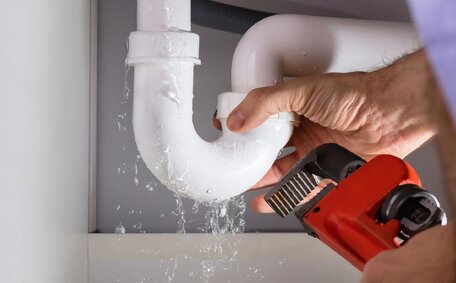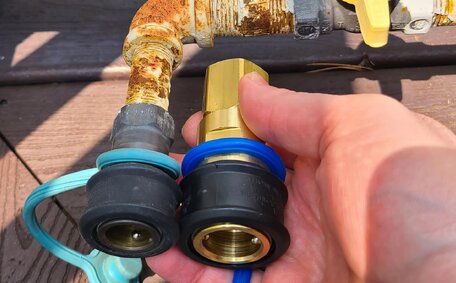Introduction to soil, sediment and blocked drains
Soil erosion and sedimentation can have a significant impact on drainage systems. When soil is washed away by rain or wind, it carries fine sediment that can clog pipes, drains, and waterways over time. This sedimentation can cause major blockages, flooding issues, and water quality problems.
Construction sites, urban runoff, and land clearing are common culprits for mobilising high volumes of sediment. As soil and debris build up, it restricts water flow through drainage infrastructure. Slow-flowing or backed-up water then becomes a breeding ground for mosquitoes and other pests.
Blocked drains also put extra pressure on ageing sewer systems, heightening the risk of pipe damage, leaks, and overflows. From an environmental standpoint, the influx of nutrients, chemicals, and other contaminants threatens local waterways and aquatic life.
Understanding the relationship between soil, sediment, and drainage is an important first step in prevention. Proper erosion control, stormwater management, and routine maintenance can help minimise blockages. When issues do occur, professional plumbing services play a key role in clearing obstructions and keeping infrastructure functioning properly.
Common sources of soil and sediment buildup in drains
There are several key sources that commonly contribute soil and sediment buildup in drains:
Construction Sites
Construction sites that lack proper erosion and sediment control measures can wash massive amounts of loose soil into nearby stormwater drains during rain events. Activities like land clearing, earthmoving, and excavation disturb and expose soil that then flows unchecked into drainage systems.
Urban Runoff
Runoff from urban areas sends high volumes of sediment, debris, oils, greases, and other contaminants into the stormwater system. Over time, this material accumulates and clogs infrastructure. Urban runoff also boosts erosion by increasing the quantity and velocity of stormwater flows.
Land Clearing
Removing vegetation for housing developments, infrastructure projects, or other land use changes strips away plant root systems that normally hold soil in place. Significant erosion issues can occur before new vegetation is established.
Natural Causes
Natural elements like wind and rain can also introduce soil into drains through typical weathering and erosion processes. Steep terrain exacerbates soil loss. Bushfires that destroy stabilising vegetation further increase runoff and sediment loads.
In areas like Gladesville, Sydney, long-term urban expansion has dramatically changed natural drainage patterns and exposed infrastructure to heightened soil and sediment loads. Routine maintenance and sediment control measures are essential to prevent cumulative buildup and serious blockages over time.
Construction sites
Construction sites are a major hotspot for soil erosion and sediment pollution. Land clearing and earthworks expose vast amounts of loose soil that can easily be washed into drains during storms or heavy rain.
Activities like excavation, grading, and soil compaction reduce infiltration rates and vegetation that would normally slow and filter water movement. This allows stormwater to accumulate and flow rapidly across sites, carrying large volumes of sediment with it.
If robust erosion and sediment control measures are not in place, construction sites can discharge extreme amounts of soil, debris and contaminants into nearby stormwater systems. Studies have shown individual sites contributing up to 200 times more sediment than natural lands.
Key preventative measures include silt fencing, sediment traps, stabilised site exits, revegetation, diversion drains and sediment basins. Such controls capture and treat sediment-laden water before allowing it to leave the site. Strict compliance checks are vital, however, as failure to properly install and maintain these measures can render them useless.
With the potential to rapidly accelerate soil erosion, construction sites must be carefully managed. If unchecked, the resulting influx of sediment can inflict serious blockage issues and water can suffer in quality in downstream drainage networks.
Urban stormwater runoff
Urban areas produce huge volumes of contaminated stormwater runoff that can clog nearby drains with sediment, litter and debris. Impervious surfaces like roads, footpaths and rooftops prevent rainfall from soaking into the ground. Instead, water runs rapidly across these hard surfaces, accumulating soap, oil, grease, nutrients, heavy metals and other urban pollutants.
When rains are intense, the influx of stormwater runoff can swiftly overwhelm drainage capacity. Temporary flood control devices like sandbags, inflatable barriers and portable pumps may be required to divert excess flows. However, more permanent stormwater management measures should also be integrated into urban planning.
Water-sensitive urban design features like rain gardens, wetlands, porous pavement and vegetated swales allow stormwater infiltration and filtration. Such natural biofilters help slow water movement across our built environment, reducing erosion and enabling the capture of sediment before it reaches the stormwater system.
How soil and sediment contribute to drain blockages
Soil and sediment contribute directly to drain blockages through physical accumulation and buildup within pipes. As erosion washes sediment from construction sites, urban runoff and cleared lands, this material is carried into drainage systems with stormwater flows.
Over time, the sediment settles out and accumulates in drains, covering the bottom of pipes. Continued deposition builds up layers of sediment that narrow the pipe diameter and restrict water flow. Excess sediment can eventually pack together to fully block water passage.
Studies show that high sediment loads from sites lacking erosion control can increase downstream infrastructure blockages by up to 500%. Built-up sediment also provides an attachment site for oils and greases. Together, this material captures passing debris, accelerating drainage blockages.
By physically obstructing pipes, the influx of soil and sediment places added strain on drainage networks. Blockages back up flows, heighten flood risks and increase overflows into local waterways. This allows large nutrient and pollution loads to enter aquatic environments, whereby waterways can become degraded, threatening habitat and species.
Physical clogging
Sediment builds up inside pipes and drainage infrastructure through a process known as physical clogging. As particles accumulate, they restrict flow capacity and place added strain on water transfer systems.
Initially, sediment deposits along the bottom of pipes as stormwater flows wash material into the network. Continued deposition causes mounds to build up. If unchecked, sediment can pack tightly enough to fully seal off internal pipe diameters.
Physical clogging also provides attachment sites for oils, greases and debris. This material traps passing litter, accelerating blockage formation. The influx can overwhelm infrastructure capacity, heightening flood risks.
To address physical clogging, skilled plumbers use high-pressure jetting to scour the internal pipe surface. Manual cleaning, scraping and flaming are also employed to remove built-up sediment. Operators must take care, however, to avoid pipe damage during these intensive removal processes.
By thoroughly clearing sediment, reliable plumbers like those at Gladesville Plumbing enable free drainage while reducing blockage recurrence. Maintaining flow efficiency protects infrastructure integrity and boosts environmental performance.
Chemical contamination
Sediment acts as a pollutant transport mechanism, carrying oils, heavy metals, nutrients and other toxic chemicals into drainage systems. Urban runoff washes motor oils and greases into stormwater, which bind to sediment particles. Construction sites, land clearing and erosion mobilise sediments contaminated by diesel spills, paints and pesticides.
Slow currents allow contaminated sediments to settle in pipes and drains. Slow currents allow contaminated sediments to settle in pipes and drains. Nutrients spur algal blooms and toxic metals accumulate up the food chain, harming aquatic life. coli can be sheltered and transferred by sediment particles.
Even pathogens like E.
Contaminated sediment threatens drinking water safety, aquatic ecosystem health and sustainable drainage function. Advanced filtration, treatment wetlands and diffusion prevention barriers can help halt chemical transfer. However, minimising erosion and urban pollution sources remains the ultimate key to control.
Preventing soil and sediment from blocking drains
There are several key steps that can help prevent soil and sediment from blocking drains:
Erosion Control
Implement erosion control measures like silt fencing, stabilisation, and sediment traps during construction or land clearing to capture runoff. Revegetate cleared sites quickly to stabilise soil.
Stormwater Treatment
Install gross pollutant traps, biofiltration systems, wetlands and retention basins to filter and settle sediment from stormwater flows before they enter drains.
Protect Drain Inlets
Use sediment controls like filter socks, inlet filters and sediment bags to capture material around drain entries and prevent it washing inside.
Routine Maintenance
Conduct regular drain inspections and cleanings to keep infrastructure clear. Jetting, scraping and sediment removal protects system capacity and function.
Following sediment control best practises during construction projects and integrating stormwater treatment into urban planning are vital to minimise erosion and safeguard drainage networks from blockages.
Vegetation buffers
Establishing vegetation buffers comprised of trees, shrubs and native grasses helps safeguard drainage systems against soil erosion and sedimentation. Plant root networks physically hold soil in place, while stems and trunks slow the velocity of stormwater runoff across sites.
Buffers trap and filter out sediment, preventing it washing directly into nearby drains. Wide, dense buffers can capture up to 90% of sediment from runoff. Vegetation also increases water infiltration into the ground, rather than allowing it to accumulate and transport pollutants.
Strategically planted vegetation filters and biostrips along waterways, drainage lines and adjacent to construction sites or erosion-prone areas provide natural safeguards. Vegetation functions as a sustainable, cost-effective first barrier against sediment and debris clogging vulnerable stormwater infrastructure.
Diverse, resilient native species suited to the local climate establish best. Proper maintenance nurtures growth. Trees and plants essentially act as living sediment control devices.
Sediment control devices
There are several types of engineered sediment control devices that help capture and filter out soil particles before they enter and clog drains:
Silt Fences
Silt fences use a woven geotextile fabric stretched across posts to create a barrier that traps sediment and runoff. They surround sites to halt erosion.
Sediment Traps
Small excavated pits or berms that pond water, allowing sediment to settle out before runoff is discharged off-site into drains.
Stabilised Site Exits
A pad of aggregate underlain with geotextile fabric that helps remove mud and debris from vehicle tyres before they leave a construction site.
Inlet Filters
Woven sediment bags, block filters, or fabric wraps secured over the opening of street drains or stormwater inlets to catch debris.
Regular inspection and maintenance is key to ensuring these devices remain functional. Installing multiple treatment stages boosts overall sediment capture from stormwater flows before they reach pipe infrastructure.
Drain maintenance and protection
Regular drain maintenance and protective measures are vital to prevent sediment buildup and blockages.
Maintenance
A consistent drain inspection and cleaning schedule will help preserve flow capacity. Plumbers should jet, scrape or flush pipes every 6-12 months to clear any accumulated sediment, debris or obstructions.
Pipe Protection
Installing sediment-control devices helps safeguard system health between maintenance sessions:
- Sand-slotted pipes have openings that allow water to filter through while capturing solid particles.
- Wrap a durable sediment sock around pipe outlets to screen out soil and particles.
- Use filter guards or traps to protect drain grates from debris ingress.
Vigilant maintenance and intake protections defend drainage networks against progressive sediment-related blockages.
Responsible drain cleaning
Responsible drain cleaning is vital to minimise environmental impacts and maintain efficient drainage function.
Chemicals and high-pressure water jetting are common clearing methods but must be carefully controlled. Indiscriminate jetting at excessive pressures can damage pipes and re-suspend compacted pollutants. Similarly, corrosive drain cleaners containing toxic ingredients like sulphuric acid or sodium hydroxide can harm infrastructure and leach into soil and groundwater if overused.
Instead, plumbers should optimise water pressures and carefully target nozzle placements to scour blockages without inflicting pipe damage. Biodegradable drain enzyme or microbial products can break down organics safely. Manual rodding, scraping or air bursting avoids chemical use entirely.
Flushed debris and sediments require proper collection for disposal rather than discharge into waterways. Responsible cleaning stops preventable pollution, while maintaining free drainage to protect property, infrastructure and the environment.
Silt bags and traps
Silt bags and traps provide a simple but effective way to capture sediment around vulnerable infrastructure. They are commonly positioned at the entry point to drainage pipes and culverts, secured with stakes or attachment rings.
As stormwater flows through the fabric or mesh device, velocity slows, allowing sediment particles to settle out. Built-up soil and debris are contained safely within the bag, rather than washing directly into the pipe or waterway. Serving as an initial barrier, silt bags prevent sediment passing deeper into the network where removal becomes more difficult.
These controls are vital for construction sites or erosion-prone areas. During intense rainfall events, they help mitigate contamination risks from the sudden influx of runoff laden with silts, clays and other particulate matter.
To maintain functionality, silt bags require frequent monitoring and maintenance when levels approach 30-50% capacity. Failure to replace near-full bags risks accumulated sediment breaking free and clogging downstream infrastructure. Responsible installation, inspection and change-out regime enhances overall drainage protection.
Conclusion
Soil erosion and the resulting sediment in stormwater runoff can have a severe impact on drainage systems. Sediment buildup from uncontrolled construction sites, urban areas, land clearing, and natural causes poses a major threat for progressive clogging and blocked drains.
Sediment physically accumulates inside pipes, narrowing diameters, providing attachment sites for debris and oils, and eventually packing tightly enough to seal off infrastructure. The influx stresses networks, heightens flood risks, and degrades water quality through rising overflows and pollution loads.
Controlling erosion sources and integrating stormwater treatment measures are essential to reduce sediment volumes entering drainage systems. Protecting vulnerable infrastructure from accumulating material is also key. This requires ongoing maintenance to clear built-up sediment and keep drains free flowing.
Left unchecked, sedimentation blockages can inflict substantial damage. By remaining vigilant and proactive with preventative steps, soil-related clogging can be better avoided. Seeking professional plumbing services provides reliable solutions when issues do arise.
For further advice on sediment control or to discuss any current drain blockages, contact a qualified plumber today to arrange an on-site inspection or maintenance cleaning.






